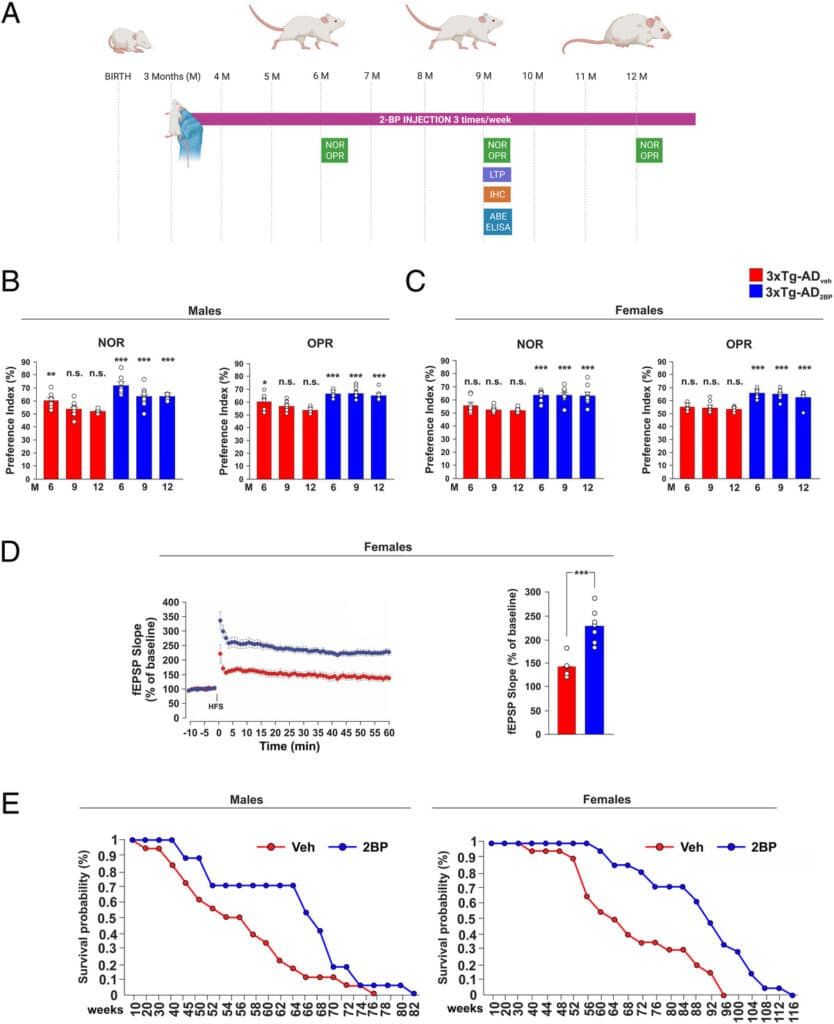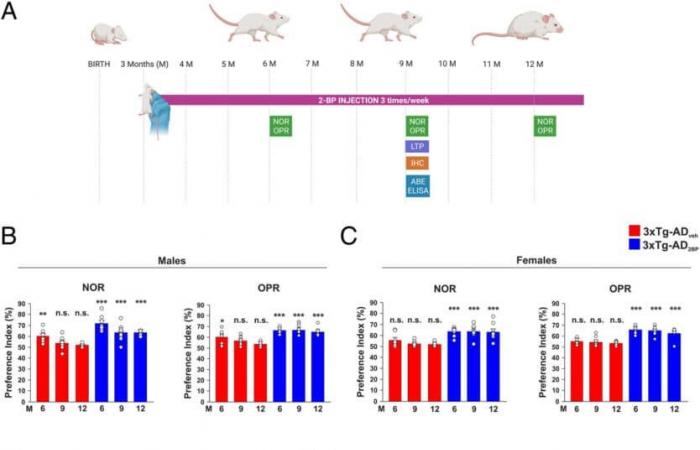⇧ [VIDÉO] You might also like this partner content
A nasal spray drug shows promising effects in reversing cognitive decline and brain damage in mouse models of Alzheimer’s. It works by inhibiting the enzyme S-acyltransferase (zDHHC). Excessively high levels of this enzyme are notably involved in the accumulation of toxic proteins linked to the disease and in the alteration of cognitive functions. Although the results are preliminary, this inhibition pathway could constitute a promising avenue for treating the disease.
The conventional hypothesis is that Alzheimer’s disease is caused by the accumulation of altered forms of certain key proteins, including tau and beta-amyloid. Beta-amyloid plaques and aggregates of hyperphosphorylated tau are considered the main features of the disease. However, the exact biomolecular mechanisms underlying Alzheimer’s pathogenicity remain partly unknown.
Studies have shown that the functions of these proteins (tau and beta-amyloid) are regulated by multiple signaling pathways, including a biochemical reaction called “S-palmitoylation”, catalyzed by the enzyme zDHHC. S-palmitoylation is a post-translational modification (PTM) affecting the localization and activity of proteins involved in synaptic plasticity. Alteration of MPTs has been shown to play an essential role in the progression of neurodegenerative diseases.
As part of a previous study, researchers from the Università Cattolica del Sacro Cuore and the Fondazione Policlinico Universitario A. Gemelli observed excessively high concentrations of zDHHC in the brains of patients who died of Alzheimer’s. They also found that these concentrations are associated with reduced cognitive performance.
Based on these observations, as part of a new study published in the journal PNASthey hypothesized that impaired S-palmitoylation of proteins regulating synaptic plasticity and beta-amyloid could play a role in Alzheimer’s pathogenicity. zDHHC could therefore constitute a potentially promising therapeutic target to treat the disease.
An enzyme potentially involved in disease progression
In their previous work, the researchers showed that altered S-palmitoylation of synaptic proteins plays a role in cognitive decline induced by certain metabolic diseases, such as type 2 diabetes. Brain resistance to Insulin can have an impact on the concentration of active zDHHC in the brain. Also note that there is a well-established link between insulin resistance and neurodegenerative pathologies, so that Alzheimer’s is sometimes nicknamed “type 3 diabetes”. A common type 2 diabetes medication was also recently shown to reduce the risk of Alzheimer’s.
In the new study, the team showed that Alzheimer’s mouse models showed increased expression of zDHHC in the early stage of the disease. They thus had unusually high levels of S-palmitoylation of proteins regulating synaptic plasticity and beta-amyloid metabolism. “
In this new study, we showed that in the early stages of Alzheimer’s disease, molecular changes resembling a brain insulin resistance scenario cause an increase in zDHHC enzyme levels and impair S-palmitoylation of key proteins involved in cognitive functions and beta-amyloid accumulation ”, explains in a blog post of the Università Cattolica del Sacro Cuore, Salvatore Fusco, lead co-author of the research.
To support these observations, researchers genetically and pharmacologically disabled S-palmitoylation in animal models. This prevented the accumulation of toxic proteins in neurons, thereby slowing the progression of cognitive decline. The lifespan of rodents was also extended.
See also
The second step of the experiment was to evaluate the effects of a zDHHC inhibitor drug called “2-bromopalmitate” (2-BP). The compound was administered to mice as a nasal spray and was found to halt neurodegeneration, reduce cognitive symptoms and extend the animals’ lifespan.


Intranasal administration of 2-BP alleviates the Alzheimer phenotype in 3×Tg-AD mice. (A) Timeline of experimental design. Male Mice Preference Index
(B) and females 3×Tg-AD (C)
treated intranasally with saline (veh) or 2-BP for 3, 6, or 9 months in NOR and OPR tests (n = 8 to 12 males and 8 to 10 females per group). (D)
Time course (left) and bar graph (right) showing the slope of LTP at CA3-CA1 synapses in hippocampal slices obtained from female mice treated with veh and 2-BP. (E) Kaplan–Meier survival curve comparing the survival probability of males (left) and females (right) treated with 3×Tg-AD with veh and 2-BP from 10 weeks of age, until death. © Natale et al.
« Our results suggest an important role for aberrant protein S-palmitoylation in the onset and progression of Alzheimer’s disease and provide evidence for the development of therapeutic approaches targeting the zDHHC enzyme “, writes the team in its document.
However, 2-bromopalmitate is not selective enough to completely inhibit zDHHC activity, the experts said. No compound currently makes it possible to selectively block the enzyme. Nonetheless, the team plans to explore other potential strategies for clinical application, including “gene patches” (delivering oligonucleotides that bind to the RNA encoding zDHHC) and engineered proteins that may interfere with the activity of the enzyme.








